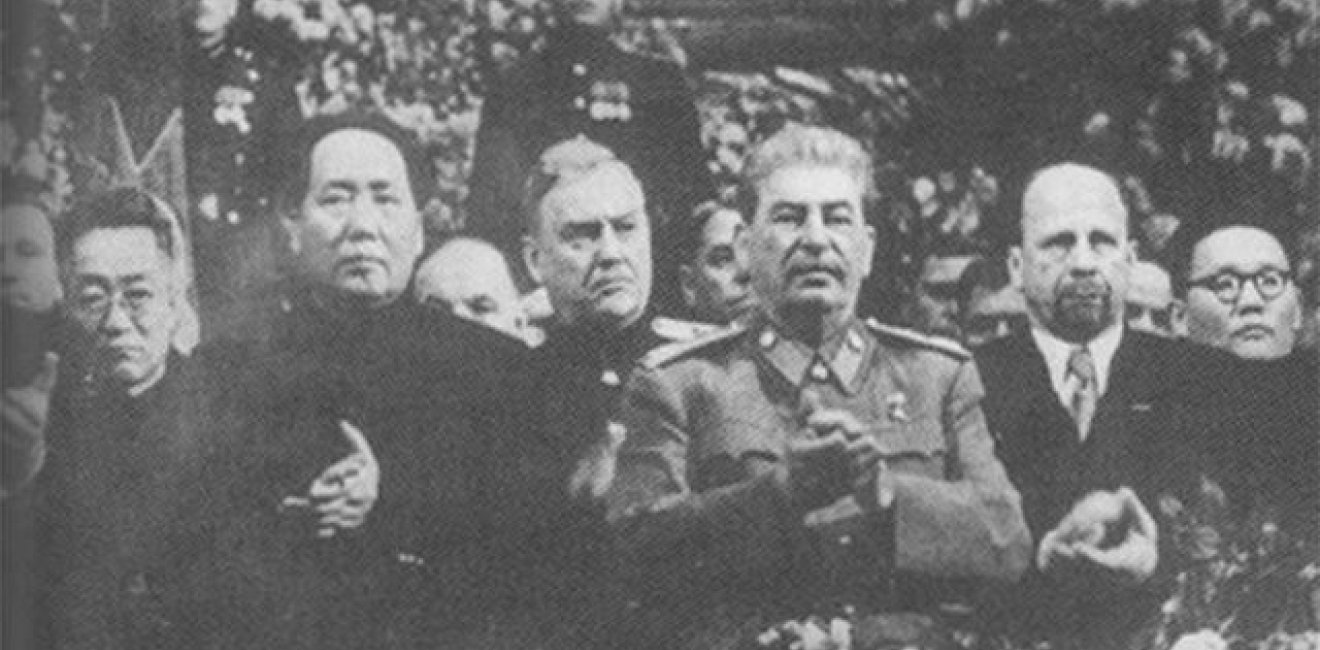The Sino-Soviet Alliance, 70 Years Later
Seventy years since the Sino-Soviet Treaty of Friendship, Alliance, and Mutual Assistance, a wealth of documentation shows the rise and dramatic fall of a critical Cold War relationship.

A blog of the History and Public Policy Program
Seventy years since the Sino-Soviet Treaty of Friendship, Alliance, and Mutual Assistance, a wealth of documentation shows the rise and dramatic fall of a critical Cold War relationship.

February 14, 2020, marks 70 years since a major Cold War turning point: the conclusion of a treaty of alliance between two communist giants, the Soviet Union and the People’s Republic of China.
The Sino-Soviet Treaty of Friendship, Alliance, and Mutual Assistance shook up global geopolitics and the balance of power between the two Cold War camps. Cooperation and close relations between the USSR and the PRC, however, were ultimately short-lived. The Sino-Soviet split from the early 1960s through the mid-1980s likewise had a dramatic effect on the global Cold War.
Thousands of primary source documents published by the Wilson Center’s History and Public Policy Program depict the evolution of Sino-Soviet relations, from the aftermath of World War II to the collapse of the Soviet Union. The documents come from archives in both Russia and China, as well as dozens of other countries in Asia, Europe, and North America.
This collection charts the bumpy road to the signing of the Sino-Soviet alliance in February 1950.
Drawn largely from Soviet records, it begins with correspondence between Mao and Stalin (as well as other Soviet officials) in 1947-1948 about a potential visit by Mao to the Soviet Union. It then turns to a flurry of correspondence and exchanges between the Soviets and the Chinese Communist Party in early 1949 – including a visit by Stalin’s emissary, Anastas Mikoyan, to Xibaipo, China – that coincided with an irreversible turn in the trajectory of the Chinese Civil War.
Following Mikoyan’s meetings with Mao, Liu Shaoqi traveled to Moscow in the summer of 1949 for further discussions about Soviet-Chinese relations. After the establishment of the People’s Republic of China in October 1949 and the formal exchange of diplomatic relations between the new regime and the Soviet Union, the Chinese and Soviets continued to arrange Mao’s long anticipated visit to Moscow.
The collection concludes with many reports and records of conversations stemming from Mao’s eventful sojourn to the Soviet Union. On December 16, during a first meeting, Stalin indicated that he did not want a Sino-Soviet alliance, leaving the new Chinese leader frustrated (and, reportedly, humiliated). But Stalin soon changed tact, and Zhou Enlai and other Chinese leaders joined Mao in Moscow and hammered out the details for the Sino-Soviet Treaty of Friendship, Alliance and Mutual Assistance, over several weeks. The treaty was concluded on February 14, 1950.
This Digital Archive collection picks up the documentary record following the conclusion of the treaty negotiations, and offers many examples of Sino-Soviet cooperation over a nearly 10-year period.
The majority of the files from the period 1950-1953 concern the Korean War: coordination between Moscow and Beijing (and Pyongyang) over China’s intervention; Chinese efforts to gain Soviet military and economic assistance in light of the conflict on the Korean Peninsula; and discussions about how best to bring the conflict to an end. In August-September 1952, Zhou Enlai paid another visit to Moscow to confer with Stalin. Zhou’s numerous briefs back to Beijing form a substantial part of the collection.
Diary entries from Pavel Yudin, the Soviet ambassador in Beijing, make up the majority of sources for the period covering the mid- and late 1950s. In July 1958, Mao and Yudin had an extremely testy exchange over a Soviet proposal to establish a joint Chinese-Soviet submarine flotilla. Mao, according to the Chinese record of the meeting, accused Yudin of “never trust[ing] the Chinese!” Mao went on to say that “You only trust the Russians! [To you] the Russians are the first-class [people] whereas the Chinese are among the inferior who are dumb and careless.”
Mao continued to debate the proposal and broader tensions in the Sino-Soviet relationship with Nikita Khrushchev in July-August 1958.
The collection also includes several files on Sino-Soviet nuclear cooperation, as well as many documents on various stressors on the Sino-Soviet relationship (such as the Taiwan Strait Crisis, the Sino-Indian border dispute, and tumult in Hungary and Poland).
Dating the exact start of the split between China and the Soviet Union (and the unraveling of their economic, diplomatic, and military cooperation) is an inherently tricky matter.
But this collection shows the Sino-Soviet alliance in turmoil from the very early 1960s: over the Sino-Indian border war; over a mass migration of Uyghurs and Kazakhs to the USSR in 1962; and over Khrushchev’s handling of the Cuban Missile Crisis, to name only a few. The withdrawal of Soviet experts from the PRC and the cancelling of Sino-Soviet nuclear cooperation offered other strong signals that the honeymoon was over.
Documents from the late 1960s and 1970s depict relations between China and the Soviet Union in light of the Vietnam War; the border war fought between the two countries in 1969; China’s courting of the United States and countries in Western Europe; and the Soviet Union’s efforts to coordinate China policy with members of the eastern bloc.
The collection includes many examples of Chinese and Soviet officials meeting with Romanians, Albanians, North Koreans, Vietnamese, and other members of the socialist bloc to discuss Sino-Soviet relations. It also shows the lengths, which both China and the Soviet Union went, to curry favor with nations in the communist world, as well as in the Third World or the Global South.
This final collection on Sino-Soviet relations in the Digital Archive shows the attempts made by Chinese, Soviet, and other international figures to achieve a modus vivendi between the two countries and put almost 15 years of bitter acrimony behind them. The Sino-Soviet “rapprochement” coincided with the immense economic, political, and diplomatic changes pursued by both China and the Soviet Union in the 1980s. The collection includes diary entries from Teimuraz Stepanov-Mamaladze from February through May 1989, as well as reconstructions of the meetings that Mikhail Gorbachev held with Deng Xiaoping and Zhao Ziyang in May 1989. These meetings took place as students and workers protested in Beijing, and just days before the brutal Tiananmen Square crackdown.
The Wilson Center's Digital Archive features a “catch all” collection on Sino-Soviet relations. This collection includes all of the documents in the preceding four collections, plus a few more that did not fit neatly into the above categories. Four other collections related to Sino-Soviet relations are also of interest:
The first two show how Soviet involvement in a borderland area of China shaped the overall relationship between the two countries, sometimes for better and sometimes for worse. The collection on the 1969 border conflict shows the relationship at its most dangerous moment. And the final collection on “Interkit” offers insights into an organization created by the Kremlin to coordinate Soviet-bloc analysis of, and policy toward, China from 1967 until the mid-1980s.


A leader in making key foreign policy records accessible and fostering informed scholarship, analysis, and discussion on international affairs, past and present. Read more


The Cold War International History Project supports the full and prompt release of historical materials by governments on all sides of the Cold War. Read more



